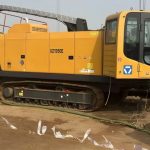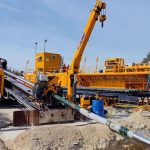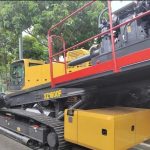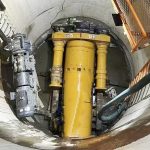Categories
Latest Updates





With the acceleration of the urban process in China, the construction of underground pipelines is getting bigger and bigger, and the people’s awareness of environmental protection has increased. Pipe jacking technology is playing an increasingly important role in the construction of underground pipelines. It can pass through urban roads, ground buildings, underground structures and various underground pipelines without large-scale excavation of the ground. It has a small working surface, low comprehensive construction cost, no blocking of traffic, no damage to roads and vegetation, and construction noise. It has the characteristics of being small and minimizing the degree of disturbance to the residents and traffic interference, which is very suitable for the construction of the complex hydrogeological conditions in the construction of the city and the construction under the conditions of the excavation restricted by the external environment.
The Binhe Road sewage pipe jacking project is located on Binhe Road on the east side of Liuyang River in Furong District, Changsha City. The position where the sewage pipe passes is surrounded by bridge piers and pile foundations, numerous underground pipelines, and passes under the underground drainage box culvert, next to the working pit 2 There is a ten thousand volt high-voltage pole at the meter. The construction site is only 40m away from the Liuyang River. The geological survey report clearly stated that the river water has a certain hydraulic connection with the groundwater in the site. Due to the influence of climate change and atmospheric precipitation, the water level is stable between 3 and 7.5m below the ground, and the sewage pipe is located at a position of 5-6m above the ground, which is in the groundwater affected area. After various scheme comparisons, it is determined to adopt the mud-water balance method for pipe jacking construction. .
(1) Initial promotion
The pipe jacking machine first enters the soil, and after entering the soil, the special correction section is spliced at the rear. During the initial jacking, the uniformity of the excavation should be ensured, and the initial deviation should be strictly controlled. At the same time, the initial deviation should be effectively controlled by adjusting the center of the rear seat jack to keep the initial state of the nose stable and the axis straight.
(2) Anti-twisting during jacking process
At the other end where the equipment and pipes are installed, a counterweight of the same weight should be configured to ensure that the weight of the left and right sides of the pipe can be balanced during the jacking process. In addition, try to avoid twisting due to human factors as much as possible.
(1) Set up an exhaust pipe in the pipe, and transport several axial fans to the wellhead by means of belt relay. If the alarm device has a display, it means that there are toxic and harmful gases in the pipe. The exhaust system should be opened immediately and the pipe The toxic and harmful gases in the gas are discharged, and the program-controlled telephone is used to contact the gas supply room to increase the actual supply of purified gas.
(2) Construct a perfect hot-fire system. On-site personnel are not allowed to use open flames at will. A certificate shall be issued before use. At the same time, there must be a full-time safety officer on site to be responsible for supervision and management, and a total ban should be banned.
(3) If the excavated soil contains biogas, and the area is large and the concentration is high, the construction should be suspended immediately, and a thorough, detailed and reasonable and feasible plan should be formulated in consultation with the technicians, and the supervision unit and the owner will be strict after review and approval. implement.
When the tunnel boring machine is close to the opening of the receiving well, the elevation and axis should be reviewed. After the complete review and confirmation are correct, all relevant preparations should be made, such as setting up the receiving platform. After the tool head enters the well wall, close the squeeze valve and remove the sealing door on the receiving well. When the jacking pipe is tunneled, it should pass through the well wall. According to the actual situation, take effective water stop measures to ensure the continuity of jacking. After being completely put on the shelves, make a permanent water stop.
(1) Ensure the stability of the excavation surface
In the process of excavation and jacking, effective measures to prevent collapse and water inrush should be taken to keep the front soil stable, while not changing its original stress state as much as possible.
The construction method used is a mud-water balance type. In order to balance the front soil, based on the nature of the soil, a wall-protecting mud with satisfactory performance is applied in the sealed cabin. In the airtight cabin, the mud pressure should be controlled within the range of 1.0 to 1.1 times the static earth pressure, and timely adjustments should be made according to the monitoring results of stratum movement. Check and block all passages that may cause slurry leakage. Check whether the tail of the tool pipe is strictly inspected to avoid the impact of mud leakage on the pressure of the front mud.
(2) Grouting in the gap around the jacking pipe
Due to the difference between the pipe diameters of the tool pipe and the pipeline, and when the tool pipe is corrected, there will be voids on the periphery of the pipeline, so grouting must be carried out during the construction. In the process of grouting, the accuracy and adaptability of the point and pressure should be ensured, and correct and feasible methods should be adopted to ensure that all voids around the pipeline can be filled with slurry. The grouting adopts thixotropic mud.
(3) Strictly control the eccentricity of the jacking force
Monitor whether the joint compression of the pipe joints is evenly compressed during the advancing process. According to the monitoring results, the stress distribution on the joint end and the eccentricity corresponding to the jacking force are calculated, and based on this, the amplitude is corrected. Avoid pressure loss of pipe joints due to large eccentricity, or ring cracks in the middle of the pipe joints, which will make it difficult to support and lubricate due to the failure of propulsion and cause uneven surface settlement.
(4) Keep the structure and soil body behind the pressure-bearing wall of the jacking pipe always in a stable state
On the basis of ensuring the structural quality of the caisson, after the caisson sinks to the designated position and the construction of the roof and floor is completed, the gap between the ground and the side of the caisson should be filled, and the soil behind the caisson should be filled. Check whether it is stable or not, and determine the limit jacking force during the jacking process based on this, and strictly control the spacing between the relays.
(5) Take effective sealing measures to prevent muddy water from entering the pipeline
Before the start of the pipe jacking construction, the overlap between the tool pipe and the pipe should be inspected to determine the ring rubber sealing device in the joint of each pipe joint, the relay room and the end of the pipe joint, the pipe joint itself and the pipe joint Waterproof of the embedded grouting hole in the middle. For reinforced concrete pipe joints, there should be a warranty certificate. It is necessary to strictly prevent the collision during the handling of the pipe joints, including the opening of the joints and the pressure loss and cracking that may occur during the correction process.
(1) Plane control
In order to ensure the continuity of the pipe jacking, the horizontal and vertical error shall not exceed 100mm, and ground wire points should be set near the head wells at both ends. According to the ground wire points and air guiding points, the method of wire measurement shall be adopted to determine the plane control points on the construction site. , And build the corresponding plane control network. For the transfer of coordinate points from the uphole to the downhole, the contact triangle method is mainly used. The reference point used to control the jacking direction in the underground can be embedded with a steel frame to form a fixed point, and the theodolite can be used to track and observe the plane deviation of the nose.
(2) Elevation control
According to the existing leveling points around the operation area, the second-class leveling line is laid, the elevation survey is carried out near the working well, and the elevation control points are set at the same time. Use level and level ruler to carry out leveling measurement, and carry out round-trip observation. After the ground elevation is transferred to the underground, it is suspended vertically with a steel ruler, and the tethering hammer is lowered, and then the ground and underground levels are observed at the same time.
(3) Observation of land subsidence
The observation point is arranged at a position 10m away from the embankment of Liuyang River by using steel pipes; the observation should be carried out every day during the construction, and the settlement shall not exceed 20mm.
(4) Pipe jacking attitude measurement
The propulsion of the pipe jacking machine must be carried out according to the axis determined by the design, the dynamic data of the pipe jacking should be observed in time, and the relevant parameters should be adjusted according to the observation results to provide correct guidance for the pipe jacking propulsion. Set the measuring target at the nose, observe the measuring target with the 2” laser theodolite and DS3 level in the foundation pit, compare the observation results, and determine the correction value. The on-site operator corrects the deviation according to the tilt angle of the nose.
This restoration construction adopts a non-excavation method, which has no impact on road traffic and effectively prevents the impact of large-scale excavation construction on the environment. After the completion of the project, the pipeline is operating normally, and the upper roads, ground buildings, and underground structures have no settlement, deformation, etc., indicating that the construction has achieved the expected results.
